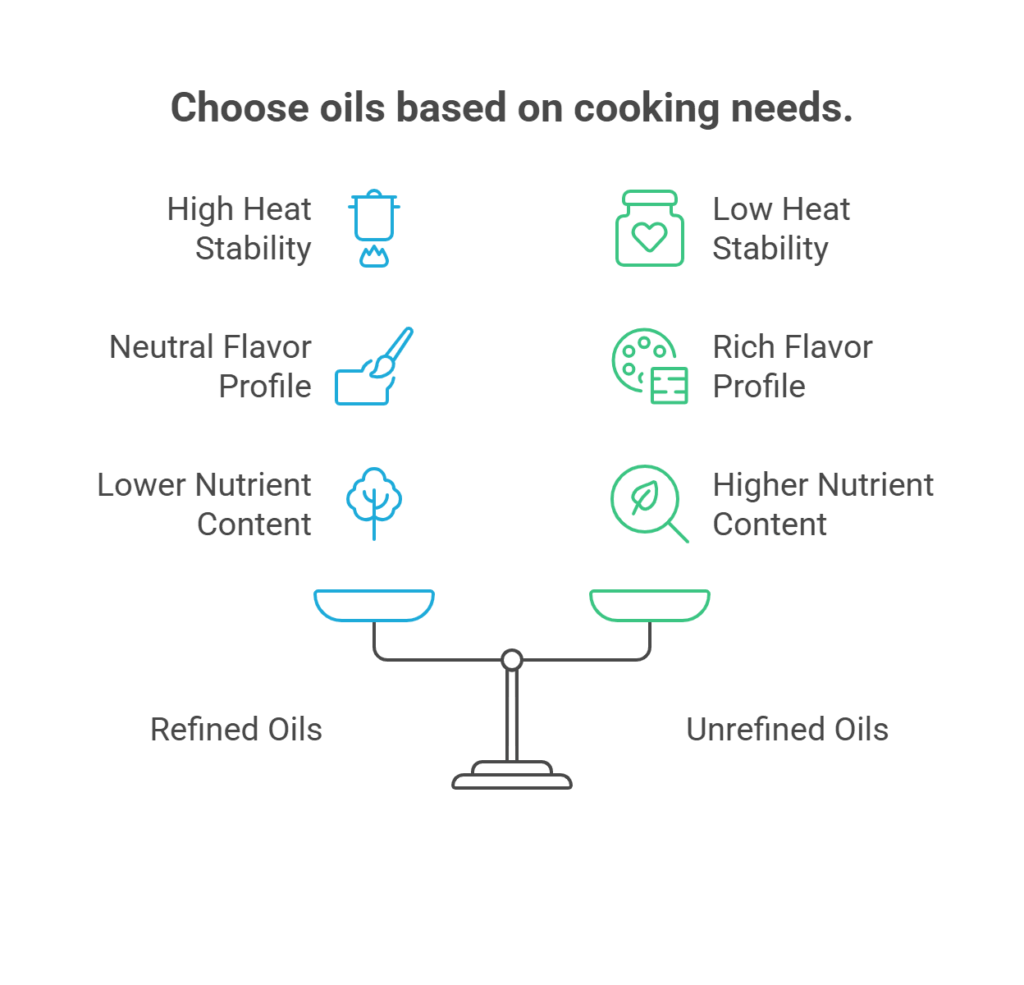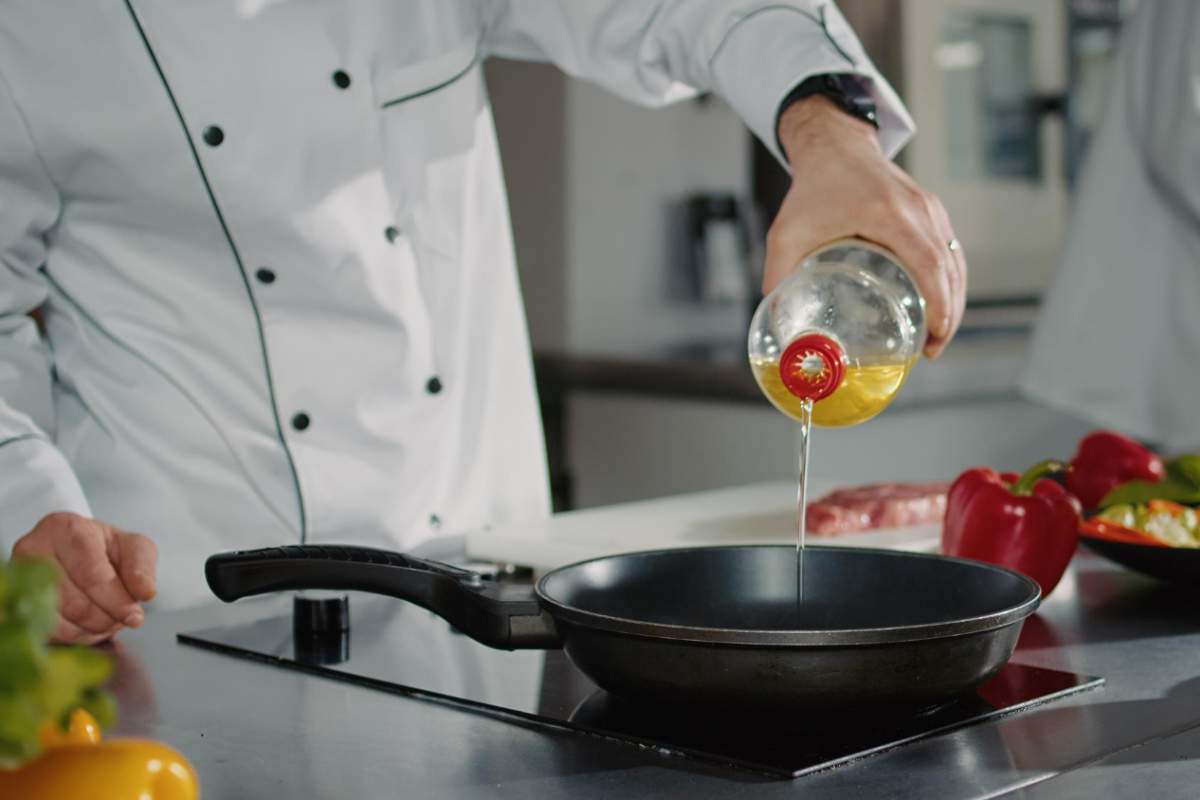Cooking oils are more than just flavor carriers. They’re gateways to safe, nutritious meals. Choosing the right oil, especially one with a high smoke point, changes everything when you’re cooking hot. Let’s dive in, with the kind of switching sentences and cadence that keeps you engaged.
Smoke Point: What It Means and Why It Matters
You know that moment when oil starts to smoke? That’s its smoke point. Past that, it breaks down, forming off flavors, free radicals, and even irritants like acrolein. Toxic. Totally unwanted. Refined oils tend to have higher smoke points because they’ve been stripped of unstable compounds. Unrefined ones? Delicious in cold dishes or drizzles, but risky for high heat.
What Happens When Oils Go Wrong at High Heat
Once oil overheats, oxidation kicks in. Free fatty acids fly apart. Harmful aldehydes emerge. The flavor turns bitter, the smell acrid. Worst of all: you might be inhaling compounds linked to inflammation and oxidative damage. Nutrients get trashed too; heat-sensitive antioxidants and vitamins start vanishing.
Why High Smoke Point Oils Are Healthier When You Cook Hot
1. Stability under Heat
Oils like refined avocado, rice bran, refined olive, and peanut endure high temperatures. Less breakdown. Fewer toxins. Consistent flavor.
2. Nutrient Protection
Stable oils preserve healthy fats, vitamin E, plant compounds. Keeps oxidative stress low, even as you sear.
3. Heart‑Healthy Fat Profiles
High‐monounsaturated oils (like avocado and olive) help lower bad cholesterol and tame inflammation. Win-win.
4. Boosted Nutrient Absorption
Fat‑soluble vitamins and plant pigments need fat to be absorbed; these oils help the body take up more from your veggies.
Top High Smoke Point Oils & What They Bring to the Table
Avocado Oil (Refined)
Smoke point around 520 °F (271 °C). Crazy heat-stable. Rich in oleic acid and vitamin E. Mild in taste, so it adapts to almost anything, from deep frying to roasting. Just pick reputable brands. Some cheaper stuff may be rancid or blended.
Refined Olive Oil (“Light”)
Smoke point near 470°F (243°C). Holds up well for sautéing or roasting. Still has heart-healthy MUFAs and antioxidants. Better than highly processed vegetable oils that skew heavy on omega‑6.
Rice Bran Oil
The smoke point is about 450°F (232°C). Neutral flavor. Balanced fats, plus compounds that may support cholesterol levels. Solid choice for frying or stir‑frying.
Refined Peanut Oil
Heat stability around 450°F (232°C). Gentle, nutty aroma. High in MUFAs. Ideal for Asian stir‑fries or deep frying. Just remember the allergen potential.
High‑Oleic Sunflower or Safflower Oil
Smoke points range from 450 to 510°F (232–266°C) depending on the brand. Very heat‑stable. Rich in vitamin E. But watch the overall omega‑6 intake if you use too much.
Refined Sesame Oil
Up to around 450°F (210–232°C) smoke point. Flavor and function combine, great for stir‑fry, quick sears. Has sesamol and sesaminol antioxidants. Use refined for heat; reserve unrefined for finishing.
Ghee/Clarified Butter & Refined Coconut Oil
Ghee around 485°F, refined coconut near 450°F. Saturated but stable. Traditional kitchens swear by them. Just moderate; they’re calorie‑dense and saturated‑heavy.
Why It’s More Than Smoke Point: Look for Nutrition Too
Here’s the key: a high smoke point alone isn’t a health stamp. Oils like soybean or corn may tolerate heat, but they’re omega‑6 loaded, heavily refined, and nutrient‑poor. That can contribute to inflammation. Prefer oils that are oxidatively stable, nutrient dense, low in omega‑6, and rich in MUFAs or antioxidants. That’s the combo that matters.
Health Perks of Using High Smoke Point Oils
Heart & Cholesterol
Consuming MUFA-rich oils like avocado and olive can reduce LDL cholesterol, support HDL, and lower inflammation.
Craving Quality Nutrition
Stable oils release fewer free radicals and harmful compounds, protecting your cells from oxidative stress.
Better Nutrition Retention
Even under medium heat, many of these oils retain vitamin E and beneficial phenols, a boost over overheated, unstable oils.
Flavor & Flexibility
These oils handle high-heat methods like frying, roasting, and searing without altering flavor. Mildness lets your ingredients shine; sesame adds nuance.
Quick How-To: Choose & Use Oils Wisely
- Match oil to method: deep frying? Try refined avocado or rice bran. Medium heat? Refined olive or high‑oleic sunflower. Low heat or vinaigrette? Go for unrefined oils like extra virgin olive, flax, and walnut.
- Watch for smoke: If oil smokes, it’s past its limit; start fresh.
- Store smart: Cool, dark spots and sealed containers are ideal. Refrigerate delicate oils.
- Use sparingly: one tablespoon ≈ 120 kcal. Portion control matters.
- Rotate oils: No single oil is perfect. Use avocado one day, olive the next, then rice bran, then sesame, for variety in nutrients and flavor.
Real‑Life Kitchen Scenarios

- Frying pakoras or chicken? Refined avocado or rice bran is your go‑to.
- Stir-frying veggies or noodles? Refined peanut or sesame oil brings stability and flavor.
- Sautéing fish or chicken at medium heat (<200 °C)? Extra virgin olive oil works well, adds antioxidants and taste.
- Roasting root vegetables: refined olive or rice bran oil keeps flavors balanced.
- Finishing a salad or making dressings: unrefined, cold‑pressed oils like extra virgin olive or walnut are nutrient‑rich and flavorful, but stay away from heat.
Busting Myths
- “Olive oil shouldn’t be heated.”
Actually, extra virgin olive oil is stable up to ~190–200 °C because of its antioxidants and MUFAs. It’s perfectly fine for medium‑heat cooking. - “High smoke point oils are always healthy.”
Not always. Some (soybean, corn) tolerate heat but are high in omega‑6, low in nutrition, and may encourage inflammation. - “Saturated fats are always bad.”
Ghee and coconut oil are saturated but stable. Used sparingly, they can be part of a balanced diet, especially in traditional cuisines like Kerala.
Why It Matters (and You Should Try It)
Believe it or not, the oil you choose next week to sear that steak or roast those veggies, impacts both flavor and your body. High smoke point oils let you cook hot without creating nasty breakdown compounds. They preserve nutrients. They support heart health. They even help your body absorb more from fresh produce. Best of all? They just taste right.
So here’s my challenge: use high smoke point oils when you cook at high temp. Rotate between them. Keep a drizzle of extra virgin for finishing. Let flavor and health go hand in hand. Smart kitchen decisions can feel simple and powerful.
Quick Reference Table
| Oil | Smoke Point | Best Use | Nutritional Highlight |
| Refined Avocado Oil | ~271 °C / 520 °F | Frying, searing, roasting | High MUFA, vitamin E, antioxidants |
| Refined Olive Oil (“Light”) | ~243 °C / 470 °F | Sautéing, medium‑heat cooking | MUFAs, moderate antioxidants |
| Rice Bran Oil | ~232 °C / 450 °F | pan-frying, deep-frying, stir-frying | Balanced fats, antioxidant plant sterols |
| Refined Peanut Oil | ~232 °C / 450 °F | Stir‑fry, frying | MUFA-rich, mild nutty flavor |
| High‑Oleic Sunflower/Safflower Oil | ~232–266 °C / 450–510 °F | High‑heat deep‑frying | Vitamin E, stable if high‑oleic |
| Refined Sesame Oil | ~210–232 °C / 410–450 °F | Stir‑fry, flavoring | Antioxidants and aromatic flavor |
| Ghee (Clarified Butter) | ~254 °C / 485 °F | Roasting, searing | Traditional, saturated fat, stable |
| Refined Coconut Oil | ~232 °C / 450 °F | Baking, quick sautéing | Saturated fat, traditional medium‑chain triglycerides |
In Summary
- Remember: storage, moderation, and rotation—they all matter.
- Oils with high smoke points allow safe, flavorful high‑heat cooking.
- But “high smoke point” alone isn’t enough; opt for oils that are nutrient‑rich, oxidatively stable, and not omega‑6 overloaded.
- Best bets: avocado, refined olive, rice bran, refined peanut, high‑oleic sunflower/safflower, refined sesame, plus ghee or coconut in moderation.








